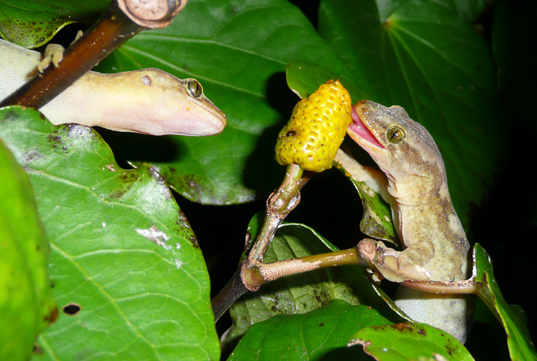Debra Wotton, Principal Ecologist & Director at Moa’s Ark Research, recently gave an invited talk on the role of lizards as seed dispersers in New Zealand at the SRARNZ (Society for Research on Amphibians and Reptiles in New Zealand) conference in Nelson. The talk was part of a special symposium to commemorate Tony Whitaker’s contribution to reptile and frog research in New Zealand. Sadly, Tony passed away in 2014.
Tony Whitaker was the first to recognise the potential role of lizards as seed dispersers in New Zealand, but evidence at that time (1987) was largely anecdotal. We now know that lizards (geckos and skinks) eat the berries of at least 23 native plant species. Lizards sometimes destroy seeds while eating or digesting berries, but many seeds survive and germinate. Both skinks and geckos move most seeds away from the parent plant, giving seedlings a greater chance of survival. Lizards often defecate seeds in rocky crevices, which they use as retreats. These crevices can provide suitable conditions for seedling establishment, and may increase seedling survival in arid and exposed habitats.

New Zealand lizards also seem to prefer eating white and blue berries. Plants with white or blue fruits tend to be shrubs and have dense, interwoven and wide-angled branches (divaricate growth form). The fruits of divaricate plants are often hidden within a dense tangle of branches, and may be difficult for larger birds to access. The divaricate form may also enable lizards to forage where they are well-concealed from predators. Fruit colour, size and plant form appear to have evolved in concert in at least some groups of the New Zealand flora, possibly under the influence of lizards.
These research findings have implications for native lizard and plant conservation in New Zealand. At some sites lizards may be the only remaining seed disperser. For example, in large areas of the eastern South Island trees and shrubs have been cleared and fruit-eating birds are largely absent. However, the abundance and distribution of lizards in New Zealand has declined dramatically since human arrival. In many areas lizards may now be too scarce to carry out their ecological role as seed dispersers. More worryingly, Terra Dumont’s research (also presented at the SRARNZ conference) indicates that even at intensively managed ‘mainland islands’ current predator control efforts are insufficient to stop lizard populations continuing to decline.
This research will be published in a special issue of the Journal of the Royal Society of New Zealand, along with other papers from the symposium.